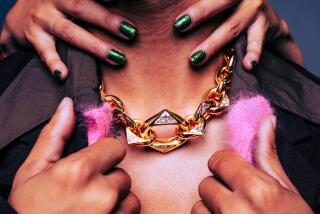A Gem of a Place to Get Educated
At this Santa Monica campus, students get a multifaceted education.
This is the world headquarters of the Gemological Institute of America, where precious stones come, by registered mail or by Brink’s truck, to be graded--and future jewelers come from around the world to learn about carats and cuts.
“We are like the Supreme Court of diamond grading and gem identification,” says GIA President William E. Boyajian. Through these portals have passed the Hope diamond (45.5 carats) and the Taylor-Burton diamond (69.4 carats).
The institute has also seen some fabulous fakes. “We get a lot of synthetics and stones that have been tampered with,” says chairman Richard T. Liddicoat. Parts of an estate piece might prove to be genuine glass. A newly purchased “diamond” might be cubic zirconia.
Liddicoat, at 78 revered as the pater familias of the gem trade, was just out of the University of Michigan in 1940 with a graduate degree in geology and a distinct desire to avoid being “sent to Venezuela or somewhere to run a geophysical crew” when GIA beckoned.
Under Liddicoat’s guidance, the 65-year-old nonprofit’s network has expanded to include three grading labs, a gem journal, an instrument line and seven campuses from Santa Monica to Bangkok. It claims as alumni most of the world’s jewelers.
On a recent morning, we came upon some grads bent over lighted microscopes in a bunker-like room to which one is admitted only after logging in twice and being buzzed through by lab superintendent Mike Clarey.
Reporting for work, each grader would typically have picked up 10 stones from inventory control. Some might have been identified by mineralogist Mary Johnson, a GIA research scientist. “They come to me when there are particularly weird problems,” she says. “Like, ‘I’m not sure what this is, but it’s 25 carats and it’s green . . . .’ ”
In the lab, each stone will be weighed and measured, then scrutinized by a team of graders for color and clarity before being given a detailed computer-generated report card. “The larger and more expensive the diamond, the more pairs of eyes examine it,” Boyajian says.
A very large stone is returned the same day and, Liddicoat mentions, is “followed step by step while it’s in our laboratories. We have to be absolutely certain that the stone [that leaves] is the stone that came in.”
Like every fingerprint, every diamond is unique. Sometimes a hot gem finds its way to the lab. “We work closely with the FBI,” Boyajian says.
In 1954, Liddicoat devised the revolutionary diamond grading system that ended “sweet grading” by flimflam dealers. Before, he says, there were multiple systems, “all so mistreated that they’d lost their credibility . . . one guy’s double A was another’s triple A.” Adds Boyajian: “In the old days, everything was ‘blue white and perfect.’ ”
Under the GIA system--now the industry standard--D1 is the top grade. Today, a GIA certificate is a guarantee. And, Liddicoat says, “Nobody in their right mind” would try to sell an ungraded diamond as D quality.
Still, there are rocks--and rocks. A 1-carat diamond has 20% more value than one weighing .99, a 2-carat stone four times the value. The round brilliant cut has the best sparkle factor, but pear shape and marquise are more popular.
Today, a flawless, beautifully cut 1-carat diamond retails for $25,000 to $30,000, the average 1-carat stone for about $5,000. By definition, “flawless” means there is no flaw visible to the trained eye at 10 power magnification. That, says Boyajian, is a fraction of 1% of stones.
The GIA boasts a collection of 17,000 gemstones, not only diamonds, rubies, emeralds and sapphires--the precious stones--but so-called semiprecious stones, a term frowned upon here. GIA librarian Dona Dirlam, who oversees the world’s most complete collection of gemological tomes, observes, “You can have a poor grade ruby and, yes, it’s red, but . . . or you can have a really exquisite tourmaline. Which one’s precious and which one’s semiprecious?”
Her staff regularly fields queries from the public. Some callers are writing books or screenplays in which gems figure. Or they might say, “I was out this weekend and I found this clear white thing. And it would scratch on glass. . . .” A dentist swore he’d grown diamonds and wanted to market them. Probably, Dirlam says, “He grew some sugar crystals.”
It is possible to “grow” synthetic diamonds from carbon but, Liddicoat says, these “haven’t dented the market” for two reasons: They’re easily identified by experts and are prohibitively costly.
Recently, Russia joined South Africa and Botswana as a major source of quality diamonds. “If people had the courage to invest,” Liddicoat says, “I think Russia in 20 years could be the most important producer,” but its technology is woefully poor.
“There will be a time in the next century,” he predicts, “when there won’t be enough diamonds to go around.” Many mines are being worked out and, with increasingly sophisticated prospecting, “They’re going to find everything that’s there to be found.”
About 250 students--most from jewelry families around the world--are enrolled in six- to 12-month courses at Santa Monica, earning diplomas ranging from graduate gemologist to graduate jeweler gemologist. Having outgrown its campus, the GIA will move in 1997 to Cardiff in San Diego County.
Current students include Mardik Oruncakciel, 21, who wants to be a jeweler in Las Vegas. His family has traded in jewelry for a century, “from Istanbul to Belgium to L.A.” And there’s Manuel Durand, 21, of Tampa, who plans to follow in the footsteps of his uncle, a jeweler in Puerto Rico.
GIA-owned gems are studied in classrooms and loaned to those taking its at-home courses. Says Liddicoat: “Our final exam is the only one I’ve heard of where the passing grade is 100”--no error in grading 100 gems. “They do, however, get five shots at it.”
A man surrounded daily by magnificent gems, Liddicoat is partial to pink sapphires and clear imperial jade. And, he adds in all modesty, he’s “particularly fond of” a tourmaline from Madagascar named in 1977 by the Smithsonian Institution. It’s called Liddicoatite.
More to Read
Sign up for The Wild
We’ll help you find the best places to hike, bike and run, as well as the perfect silent spots for meditation and yoga.
You may occasionally receive promotional content from the Los Angeles Times.






